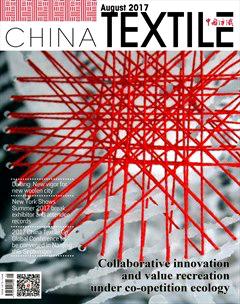Dear readers
In August, global attention is drawn to China as Chinese military parade flexed its muscles to celebrate 90-year-old birthday, I would continue to usher our readers into Xinjiang, Chinas far-west territory, for another strength-building pageant featuring panoramic activities that include Eurasia Trade Exhibition, Belt & Road Initiative Conference for Textile and Garment Development, and the annual industrial clusters convention jointly hosted by China Knitting Industry Association and China Cotton Industry Association, all of which are scheduled on August 24th - 27th.
Tight-scheduled events for textile and apparel come on stream one after another in Xinjiang, indicating that the Chinese Far West has blossomed into the industrial centre in labour-intensive textile and apparel regime beyond its geographical distance. The photo given above shows Mr. Yu Zhengsheng, Chairman of Chinese Peoples Political Consultative Conference(CPPCC) is talking with Mr. Chen Jianhua, president of Xinjiang Kashghar Gloves Manufacturing Company, over the issues pertaining to business environment, employment, clients orders, local workers wages and things of concerns in expanding production bases.
Mr. Chen has six companies in the same business line in Jining city of Shandong Province, east of China, and in the past three years, he invested in 19 new operations for gloves export business on OEM basis in Yingjisha county of Kashghar, Xinjiang Autonomous Region. His investment goes to small operations scattered in different local villages while he keeps the production management centre in the large industrial park, the manufacturing model is referred to as “Center+Satellite” operation, allowing workers to have jobs in the vicinity of their homes where these Kashgharians can both work for the company and take care of house chores. He provided approximately 3,000 jobs in the local county, making it possible for the first time in the local economy to have export business in the largest gloves production base in the West of China .
Xinjiang is the only province that has set up a special administrative office for promoting textile and apparel industry and employment, showing the paramount importance of textile industry in boosting local economy with growing employment to fight poverty and maintain social stability. According to the statistics just issued by this textile industry and employment promotion office of Xinjiang local government, the first half of 2017 witnessed a chalk-up by 48.1 percent with 24.364 billion yuan (over 3.6 billion dollars) investment in the fixed assets of textile and apparel industry, providing 35,000 jobs. To be more exact, there are 463 key projects relating to textile industry, of which there are 172 infrastructure projects, 98 projects are already under construction.endprint
Apart from these supporting investment from local government, the private sector has also increased investment in new expansions that break down into 291 important projects, out of which, 254 projects have already broken the ground, reaching start up rate by 84 percent. With this, Xinjiang has additionally got 442 new textile and apparel companies, 138 companies from outside investors and 297 companies from local new operation expansions with their owners also from outside investors, representing 67.2 percent in the total number of newly invested companies in Xinjiang from January to June this year.
Seated at the gateway to the world on route to the west of Asia and to Europe along the Silk Road Economic Belt, Xinjiang enjoys a variety of special advantages with respect to raw materials, electricity prices, land, labor costs, tax incentives,and geographical pivot in westbound exports on road and rail transportation, making it out of question for new investments to flow into textile and apparel industry, backed up by an abundance of cotton acreage and vertically-integrated fiber-to-fashion value chain. The annual business rendezvous of EuroAsia Trade Fair and Textile and Apparel Forum under the Belt & Road Initiative is very instrumental in facilitating investments not only in Xinjiang, but also in other countries along the ancient silk road. With this notion in mind, we should walk together off the beaten track.
ZHAO Hong Editor-in-Chief
August 2017endprint
- China Textile的其它文章
- Collaborative innovation and value recreation under co-opetition ecology
- Dalang New vigor for new woolen city
- NUOYI Technology+Ideas+Talents make the extraordinary
- EcoChic Design Award 2017 finalists photoshoot
- New York Shows Summer 2017 break exhibitor and attendee records
- Online application for ITMA ASIA+CITME 2018 exhibition space opens

